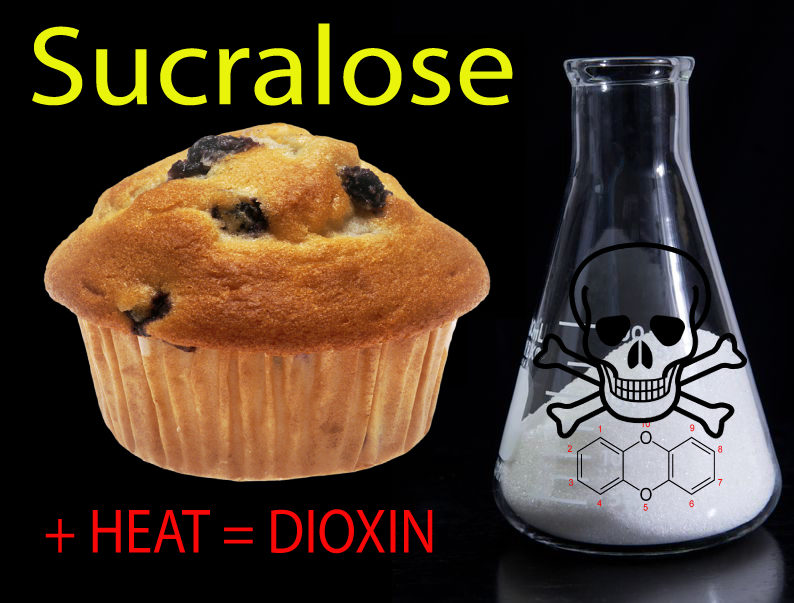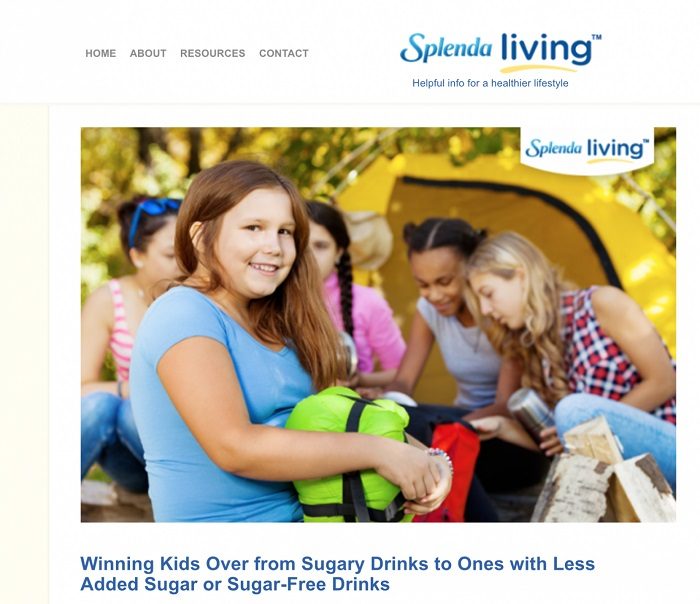A review on the synthetic sweetener sucralose (marketed as Splenda), published in the journal Toxicology and Environmental Health, overturns widely held misconceptions about the purported safety of this ubiquitous artificial sweetener.
Found in tens of thousands of products and used by millions of consumers around the world, sucralose's unique ability to dissolve in alcohol and methanol as well as water, makes it the most versatile and therefore most widely used artificial sweetener in production today. And yet, its popularity is no indication nor guarantee of its safety, as is evidenced by the widespread use of other artificial sweeteners like aspartame, which while being safety approved in 90 nations around the world, has been linked to a wide range of serious health conditions including possible neurotoxicity.
But tide is turning...
Back in 2013 year, the Center for the Public Interest in Science downgraded Splenda from "safe" to "caution," citing their need to evaluate a forthcoming Italian study linking the artificial sweetener to leukemia in mice as a basis for their decision.
Another human study published around that time linked Splenda to diabetes-associated changes, calling into question its value as a non-calorie sweetener for those suffering with, or wishing to prevent, blood sugar disorders.
The 2013 review, however, may be the most concerning yet to surface in the peer-reviewed literature. Titled, "Sucralose, a synthetic organochlorine sweetener: overview of biological issues," it reveals an extensive array of hitherto underreported safety concerns, not the least of which is the formation of highly toxic chlorinated compounds, including dioxins, when Splenda is used in baking, an application which its manufacturer, McNeil Nutritionals (a subsidiary of Johnson & Johnson), actively encourages it to be used for, including targeting children as ideal consumers.
[see: Cooking and Baking: SPLENDA®]
A Dizzying Array of Splenda (Sucralose) Safety Concerns That Have Never Been Adequately Tested
The study argues that, despite its widespread approval and use, further scientific safety research is warranted due the following significant findings:
- "Sucralose alters metabolic parameters and its chronic effects on body weight are unknown": both animal and human research indicates sucralose may raise blood sugar and insulin levels, indicating it may have diabetogenic properties.
- "Sucralose alters P-gp and CYP expression": While classified as a food additive, sucralose's organochlorine structure indicates it interferes with a wide range of organochlorine class drugs, and activates detoxification pathways and enzymes, in a manner similar to these xenobiotic chemicals.
- "The metabolic fate and health profile of sucralose metabolites are currently unknown": Contrary to statements in the research literature that sucralose passes through the body in the feces 'unchanged,' metabolites have been detected in the urine and feces of both animals and humans, the nature and health consequence of which have never been studied.
- "Sucralose alters indigenous bacterial balancein the GIT": Sucralose (delivered as Splenda) has been found to reduce the number of beneficial bacteria in the gastrointesintal tract (e.g., lactobacilli, bifidobacteria), while increasing the more detrimental bacteria (e.g., enterobacteria). One study found the adverse effects on flora did not return to normal (baseline) after a 3-month recovery period. Sucralose also altered the pH of the gastrointestinal tract.
- "Numerous toxicological issues regarding long-term exposure to sucralose are unresolved": 1) DNA damage (genotoxicity), and possible adverse epigenetic alterations. 2) The generation of toxic compounds during baking, including chloropropanols, 1,6-DCF and dioxins. 3) The bioaccumulation of sucralose and/or its metabolites. 4) The interaction between sucralose and/or its metabolites with drugs have not yet been studied or evaluated. [emphasis in bold and red added]
As the reader can plainly see, the picture is a complex one, and there are more unresolved questions than answers. But perhaps the most concerning issue addressed in the report is the 'Safety of Sucralose That Has Been Heated.' According to the paper, historically, sucralose was reported to be heat stable at temperatures used in cooking. But they cite a number of reports from independent laboratories showing that sucralose undergoes thermal degradation when heated. One study showed that the stability of sucralose decreased as the temperature and pH increased, with the breakdown process commencing at 119 degrees Celsius and temperatures of 180 degrees Celsius causing its complete degradation at all pH levels with the release of chloride ions. Additionally, they refer to research showing that sucralose can break down into the following concerning compounds when heated:
- Chloropopanols are generated when sucralose was heated in the presence of glycerol. Chloropopanols are a group of contaminants that include known genotoxic, carcinogenic and tumorigenic compounds.
- Other chlorinated compounds formed when sucralose is heated in the presence of food include dibenzo-p-dioxins, dibenzofurans, dioxin-like polychlorinated bisphenyls and polychlorinated naphthalenes.
The discovery that thermal breakdown through cooking can lead to the formation of highly toxic and equally persistent chlorinated compounds, including dioxins, should raise a series of red flags for consumers, manufacturers and regulators as the information becomes more widespread. A cursory perusal of the World Health Organization's description of 'Dioxins and their effects on human health,' which lists it as belonging to the "dirty dozen" of the world's most dangerous pollutants, will see what is at stake here. Here are the key facts on dioxin from the WHO document:
For more information on the formation of toxic chlorinated byproducts following the heating of sucralose read a 2013 study published in Scientific Reports titled, "Polychlorinated dibenzo-p-dioxins and dibenzofurans formed from sucralose at high temperatures," which goes into the topic in greater depth.
- Dioxins are a group of chemically-related compounds that are persistent environmental pollutants (POPs).
- Dioxins are found throughout the world in the environment and they accumulate in the food chain, mainly in the fatty tissue of animals.
- More than 90% of human exposure is through food, mainly meat and dairy products, fish and shellfish. Many national authorities have programmes in place to monitor the food supply.
- Dioxins are highly toxic and can cause reproductive and developmental problems, damage the immune system, interfere with hormones and also cause cancer.
- Due to the omnipresence of dioxins, all people have background exposure, which is not expected to affect human health. However, due to the highly toxic potential, efforts need to be undertaken to reduce current background exposure.
- Prevention or reduction of human exposure is best done via source-directed measures, i.e. strict control of industrial processes to reduce formation of dioxins.
The Acceptable Daily Intake of Splenda (Sucralose) May Have Been Set 100's of Times Too High To Ensure Safety
Lastly, an equally concerning issue addressed by the paper is the problem of the acceptable daily intake (ADI). The FDA approved an ADI for humans of 5 mg/kg/day in 1998 based on toxicity studies in rats by determining a no-observed-effect level (NOEL) of 500 mg/kg/day, and then applying a 100-fold safety factor. Since then, research has emerged showing that the NOEL in the microbiome ('gut bacteria') of rats for Splenda is actually as low as 1.1 mg/kg/day - 454 times lower than first determined - and 3.3 mg/kg/day for changes in intestinal P-gp and CYP - 151 times lower than first determined. Therefore, if the biological effects of sucralose in rats and humans are the same, or similar, then significant effects would be expected in humans far below the ADI.
Given the clear indication of harm associated with Splenda, as well as the fact that heating Splenda as advised by the manufacturer can release toxic dioxin, we call on McNeil Nutritionals to clearly label the risks of their product both on the product packaging and website.
For additional research on sucralose's adverse health effects, visit our research page that collates peer-reviewed research on its toxicological properties. You can also read our article: Top 5 Reasons Never To Use Splenda. Also, for research on natural sweeteners not associated with these adverse effects, take a look at the following alternatives. To learn more on safe, natural alternatives read: 4 Sugar Alternatives That Won't Poison You
Sayer Ji is founder of Greenmedinfo.com, a reviewer at the International Journal of Human Nutrition and Functional Medicine,Co-founder and CEO of Systome Biomed, Vice Chairman of the Board of the National Health Federation, Steering Committee Member of the Global Non-GMO Foundation.





Comment: For more on the serious dangers of dioxin, see: